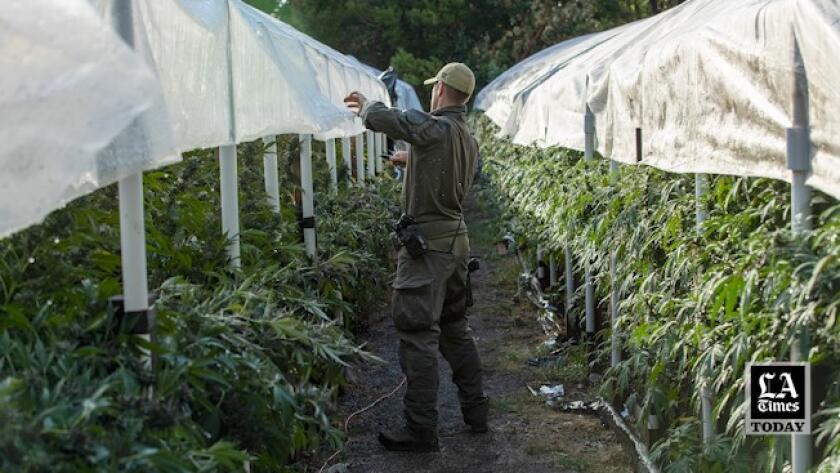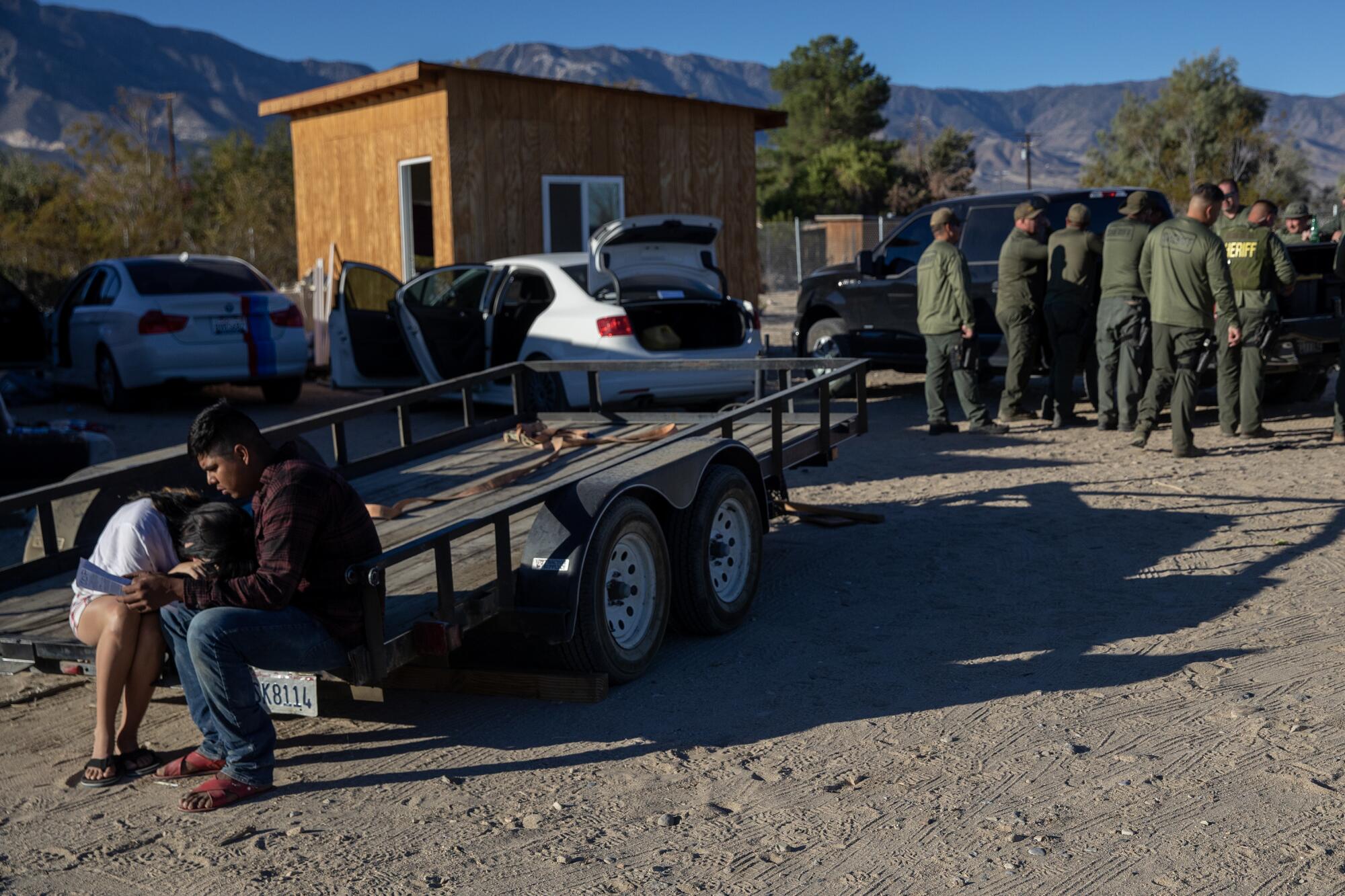
- Share via
Sareth Sin, 67, died upright, seated in a plastic chair, on Christmas Day. He was asphyxiated by fumes from the generator he ran to chase the desert chill out of a cannabis greenhouse on the eastern edge of Los Angeles County.
Leuane Chounlabout, 79, was found lifeless, lying on his back surrounded by a tangle of electrical cords connecting heat lamps to a greenhouse generator outside Palmdale. He had arrived two days earlier to help harvest.
Miguel and Rufino Garcia Rivera, 28 and 36, collapsed on the floor of a desert greenhouse not far away that reeked of diesel and pesticide fumes. The brothers, recent arrivals from Mexico, died of carbon monoxide poisoning near the small cannabis plants they had been hired to cultivate.
For millions of consumers, the legalization of cannabis has brought a multibillion dollar industry out of the shadows and into brightly lit neighborhood dispensaries.
But California, birthplace of both the farm labor movement and counterculture pot, has largely ignored the immigrant workers who grow, harvest and trim America’s weed. Their exploitation and misery is one of the most defining, yet overlooked narratives of the era of legal cannabis.
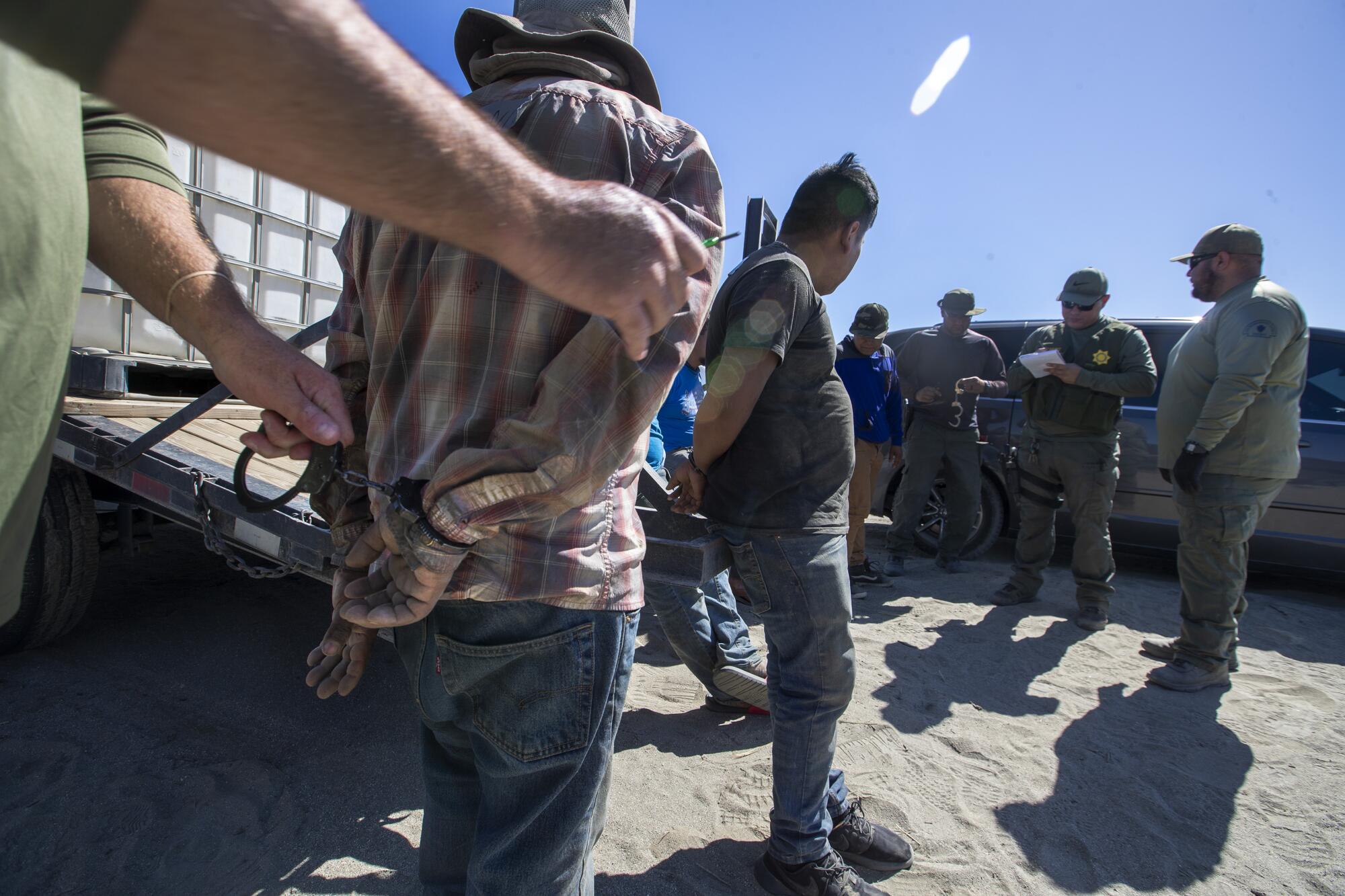

From the forests of Oregon to the deserts of California, a Los Angeles Times investigation found, cannabis workers are subjected to abuse, wage theft, threats of violence and squalid and hazardous conditions. They are disregarded even in death.
At least 35 workers died on cannabis farms in a five-year span through 2021. Twenty died in carbon monoxide poisonings, according to coroner records. Their deaths were tied to substandard living conditions and a shift to growing in greenhouses to increase profits. Only one led to a workplace safety investigation.
Workers described living outdoors, without sanitation or sufficient food, and told of employers who directed them to charity food banks or ran them off at gunpoint without pay. While accompanying police on raids, Times journalists saw hazardous pesticides frequently in use, including at a San Bernardino County farm where a young couple slept in a shed next to a greenhouse that reeked of metamidofos, a deadly nerve agent no longer sold in the United States but still available in Mexico. The young woman said she was pregnant.

By searching private forums and official complaints, The Times counted wage theft claims against more than 200 farms, half of them licensed. The workers who turned to the state for help collecting pay faced wait times of more than a year if they did not settle or abandon the claim first.
Even when farms were inspected, regulators focused on water runoff and the noise level of generators, not on laborers who were unpaid and slept in tents and barns.
“We’re disposable,” said a man who worked at a licensed operation in Northern California where dozens of workers were unpaid for two years.
For years, the sheriff’s deputies who raided illegal grows regarded cannabis workers as criminal suspects, chasing them down, handcuffing them and sometimes hauling them to jail for mug shots.
But on a November raid three years ago, Butte County Sheriff Kory Honea had a shift in perspective.
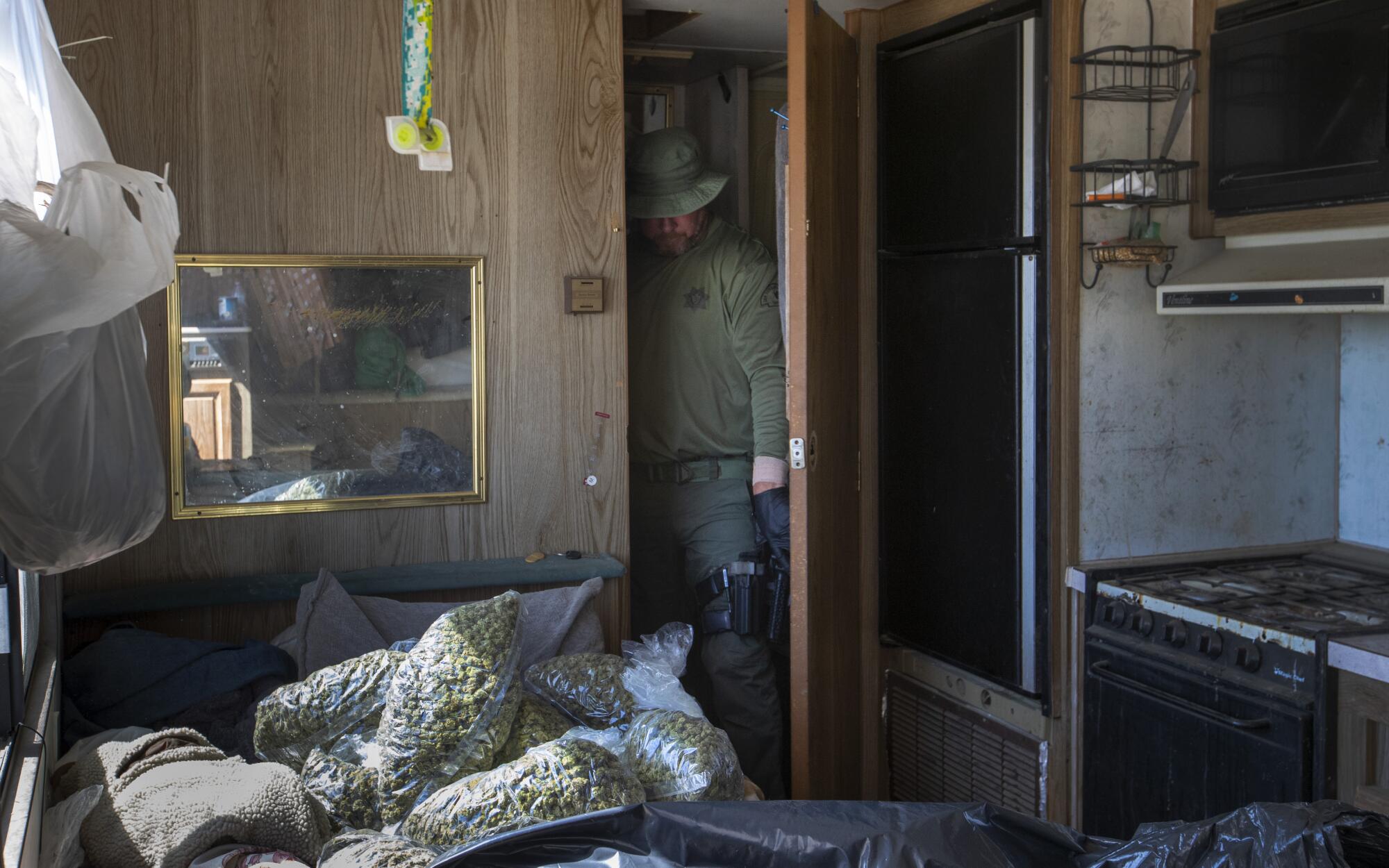
A Western sheriff still fighting the war on drugs, Honea watched as 15 people tried to flee when deputies stormed a cannabis farm in Berry Creek. Three turned out to be bosses, who had assault weapons and body armor on the property. The 12 workers, all from Mexico, were without cellphones or passports. Honea said investigators learned the travel documents were stashed at a different location, suggesting the workers were being held captive for their labor.
“Under no circumstances,” Honea said, “would any worker in any other industry, or for that matter in legitimate agriculture, be required to live in the conditions that these people are required to live in.”
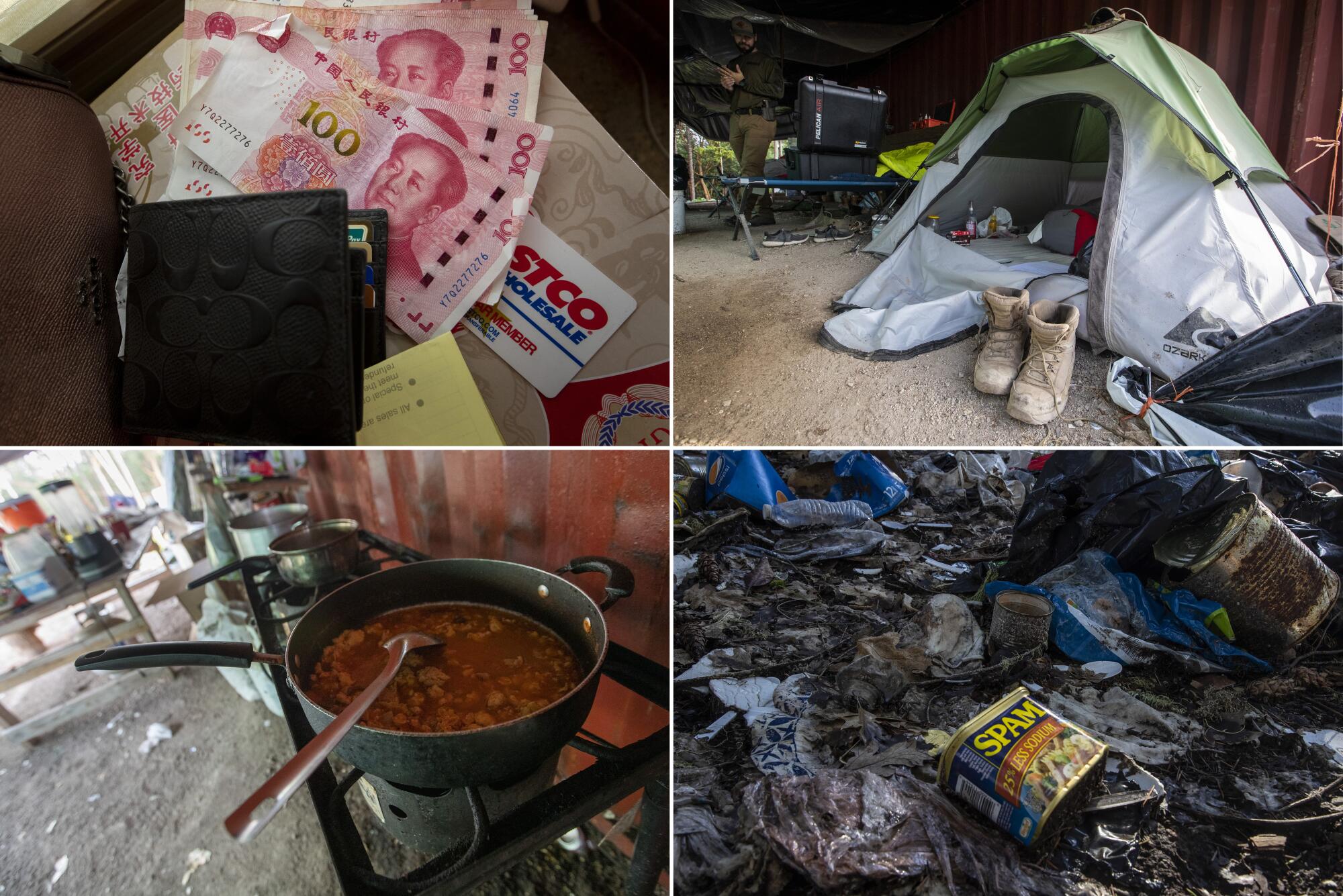

Few crops are as labor-intensive as cannabis.
From the nursing of young clones to the trimming of dried flower buds for market, every step requires human hands. On most farms, it is hard labor. Workers physically lug heavy bags of soil and fertilizer, and in some places, must carry buckets of water to plants on steep slopes.
California’s historical cannabis farms relied on local networks of friends and family for labor. Legalization brought a rush of market speculators and dramatically changed labor conditions.
The new growers built massive greenhouses, increasing demand for mobile trimming crews who travel with their own tents, sometimes under the control of middlemen who take a cut of their earnings.
The farms recruit from Chinese communities in Los Angeles and New York, from Hmong enclaves in Wisconsin and among Mexican laborers working in San Jose and the farmlands of the Central Valley. They also pull workers directly out of economically depressed countries, such as Argentina and Chile, attracting some who are teachers, biologists and physical therapists.

But the rush to capitalize on legalization flooded the market, crashing both wholesale crop prices and the pay for farmworkers.
Four years ago, trimmers received $200 a pound or more for cutting the tiny leaves off dried cannabis buds, the most labor-intensive part of cultivation. The current rate is $80 a pound, and The Times found jobs quoting rates as low as $50 — well below minimum wage for slower workers.
Wage theft allegations skyrocketed.
Chris Van Hook, who runs Clean Green Certified, a private cannabis farm inspection company, said farmers in the broader agricultural community know that if they don’t provide workers with proper housing, restrooms and access to food and water, state regulators “will come down on you very hard.”
But cannabis work is different.
“The state agencies have completely turned a blind eye to the cannabis industry,” he said.

At the top of the steep grade, Chicken Ridge narrows, and the dirt road ends at a gate. A plaster angel holding the word “Welcome” stands next to a metal sign warning of attack dogs.
To the left, in the woods, were the tents of cannabis workers.
Half a dozen workers shared photographs and provided details of their lives last year on the licensed farm in Mendocino County. Their tents and vehicles encircled a giant oak, and an outdoor kitchen consisted of a propane stove propped on wooden pallets beneath a tarp. They said there was one toilet, so they often defecated in the woods. They warmed water for showers in black buckets hung in the sun.
And they grew a lot of cannabis — 1,000 plants, according to the farm manager’s records.
By December, a payroll ledger showed, the farm owed 25 workers more than $100,000.

The cannabis licenses were in the name of Mountain Top Management, a corporation held by Mike Womack, a North Carolina trucking company owner who showed up only sporadically.
Month after month, WhatsApp exchanges shared with The Times show, Womack responded to workers’ requests for pay by asking for more time to come up with their money. He blamed their lack of pay on falling market prices, crop losses from mold and most emphatically, on the woman he had hired to run the farm.
“Just been really horrible trying to pay so many people. Trying not to go out of business,” Womack wrote in March to a worker. “I am so ... broke right now.”
“I understand your situation but need you [to] understand mine and negotiate,” another worker told Womack. “I have no money and need food.”
Womack responded to phone calls from a Times reporter with a text message saying it was a bad time for him but he would talk later. He then stopped responding to calls and messages altogether. A farm employee from Spain instead called at what he said was Womack’s direction, to contend that Womack had no responsibility for paying people the manager brought onto his farm. “Mike had no workers,” Diego Alberto said.
Five workers have since filed claims with California’s labor agency, seeking $96,000 from Womack. An Argentine woman and her husband, a teacher, said they were owed more than $6,500, more than most Argentinians earn in a year. She said she was happy when Womack finally wired them $600.
“You play the game, know the risk,” she said.
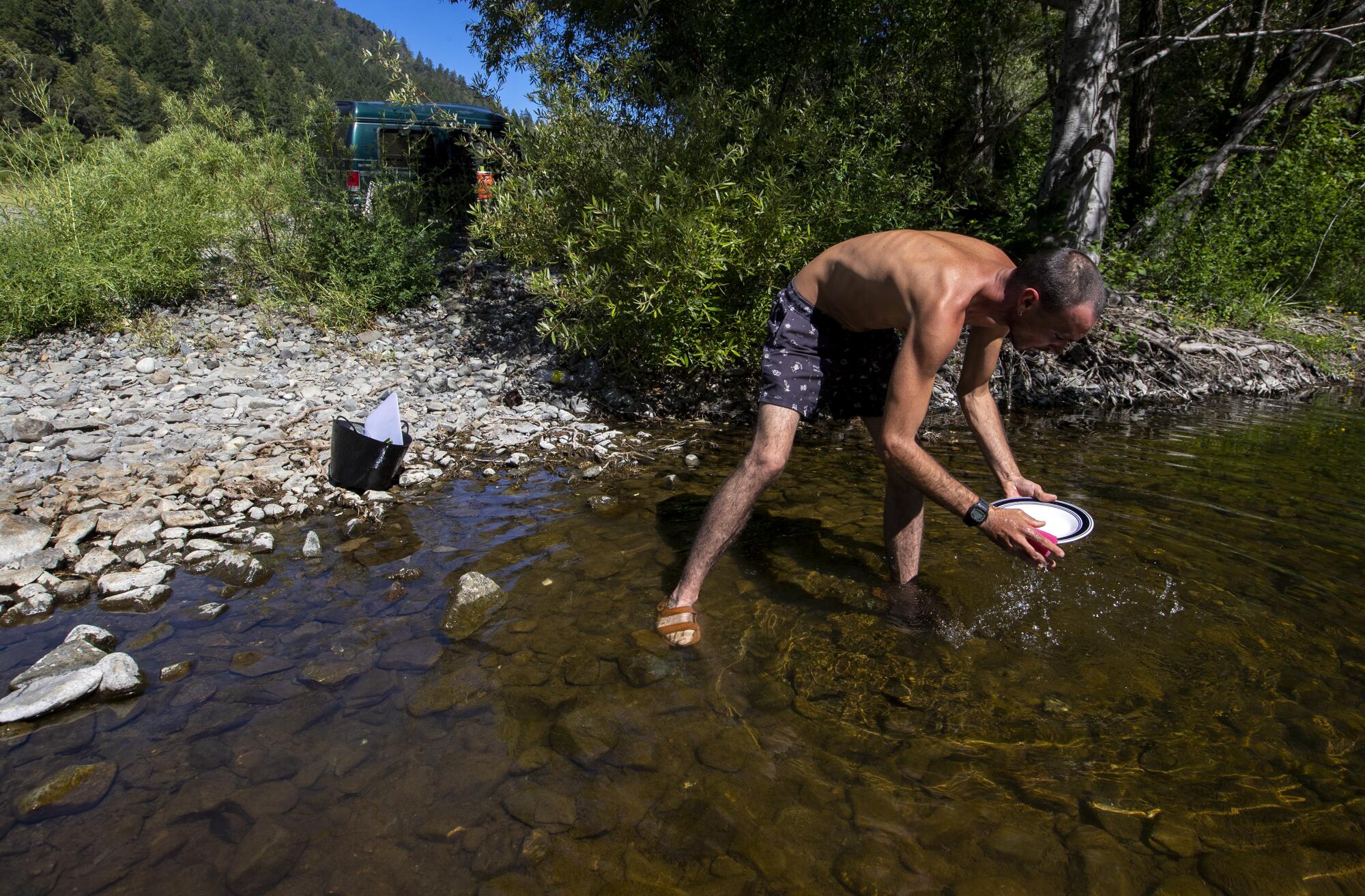
A 32-year-old Portuguese worker who asked to be identified only by his first name, Cristiano, was convinced that if he left the Covelo area, he would never see the money he said Womack owed him. The farm’s payroll sheet said he was owed at least $4,300.
He spent the winter in the valley, living in a 1999 Ford Econoline van with a tiny wire-haired dog named Calif.
Times journalists found him still there in the spring. Foam pads insulated the van’s windows, and a massive pile of donated blankets crowded the plywood bed. Vinyl flooring tacked atop the floor was beginning to curl.
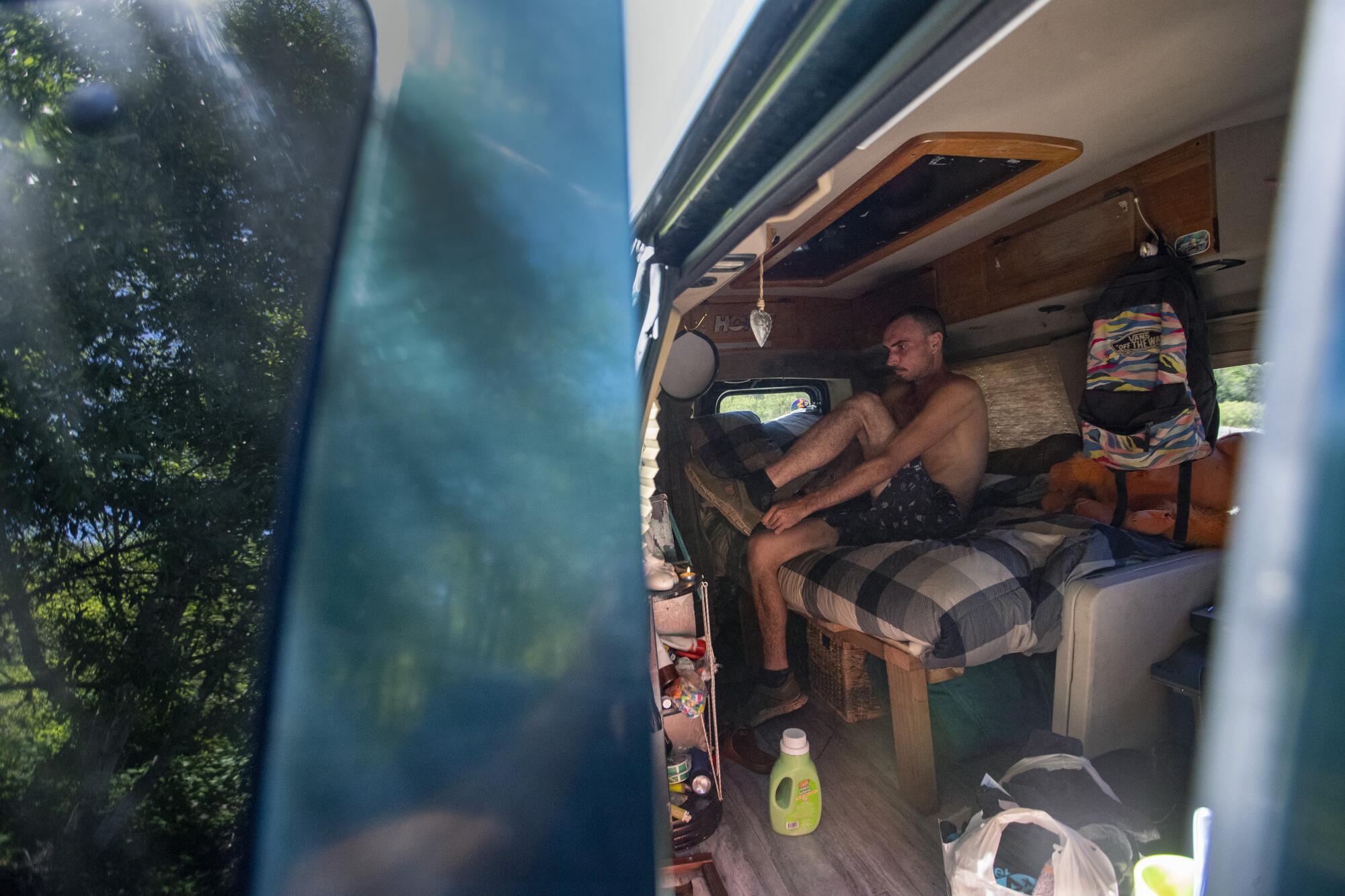
Cristiano said his savings were depleted. His eyes were sunken, and his cheekbones protruded. Cristiano said he had lost about 22 pounds. He raised his thin arms to demonstrate.
He had come to the United States, drawn by talk of quick cash on cannabis farms. He intended to stay three months, but it had been two years.
The winter was demoralizing, he said. “I had a lot of nights crying, ‘What the hell am I doing here? Why? Why did I decide to come here and end up like this?’ Swearing a lot, like, ‘Why? Why?’”
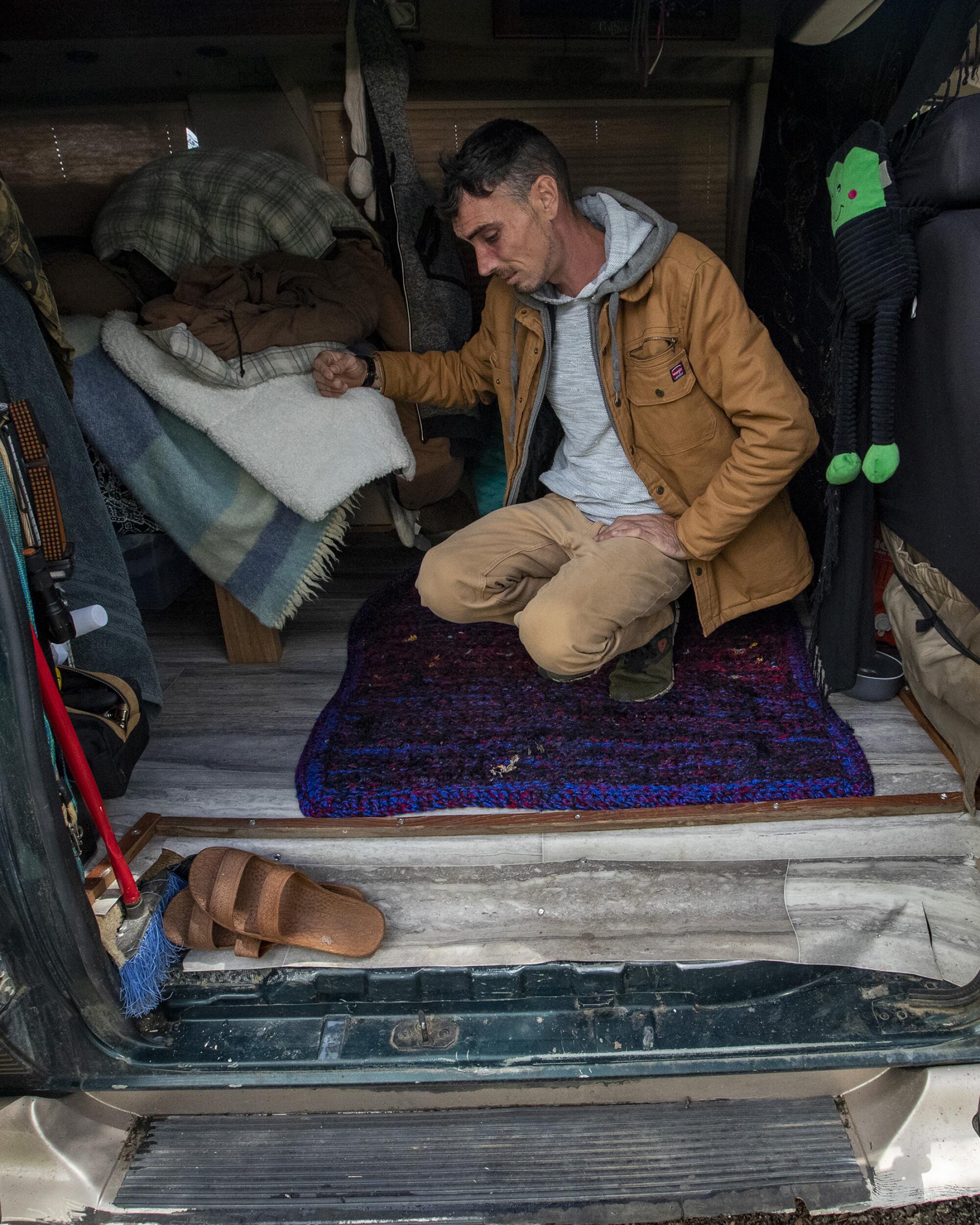

In many ways, Joey Jiorle felt invisible.
The day California cannabis regulators raided the licensed Humboldt County farm where the 34-year-old man worked, inspectors looked at the unpermitted hut where Jiorle had his bed and his belongings.
“They said, ‘You know, nobody’s supposed to be living here,’” he said. And they moved on.
On a wintry day in March, a piece of heavy farm equipment nearly severed his finger. At the hospital where it was reattached, a nurse asked if Jiorle had insurance from work. No, he said. He was working off the books, promised $20 an hour but unpaid for four months.
The farm’s county-approved operations plan declared only two workers would live on site, negating the need for housing. It never had fewer than six, Jiorle said, and for weeks at a stretch during harvest, more than 50 people would camp on the property. One November, trimmers set up their tents inside an empty greenhouse, and the structure collapsed during a heavy overnight snowfall.
Another farm in Mendocino County declared a single employee, though payroll sheets showed more than 30 workers. Two ridges away, another large farm said it would have no workers.
Though they didn’t exist on paper, these workers were not entirely invisible to the regulatory system.
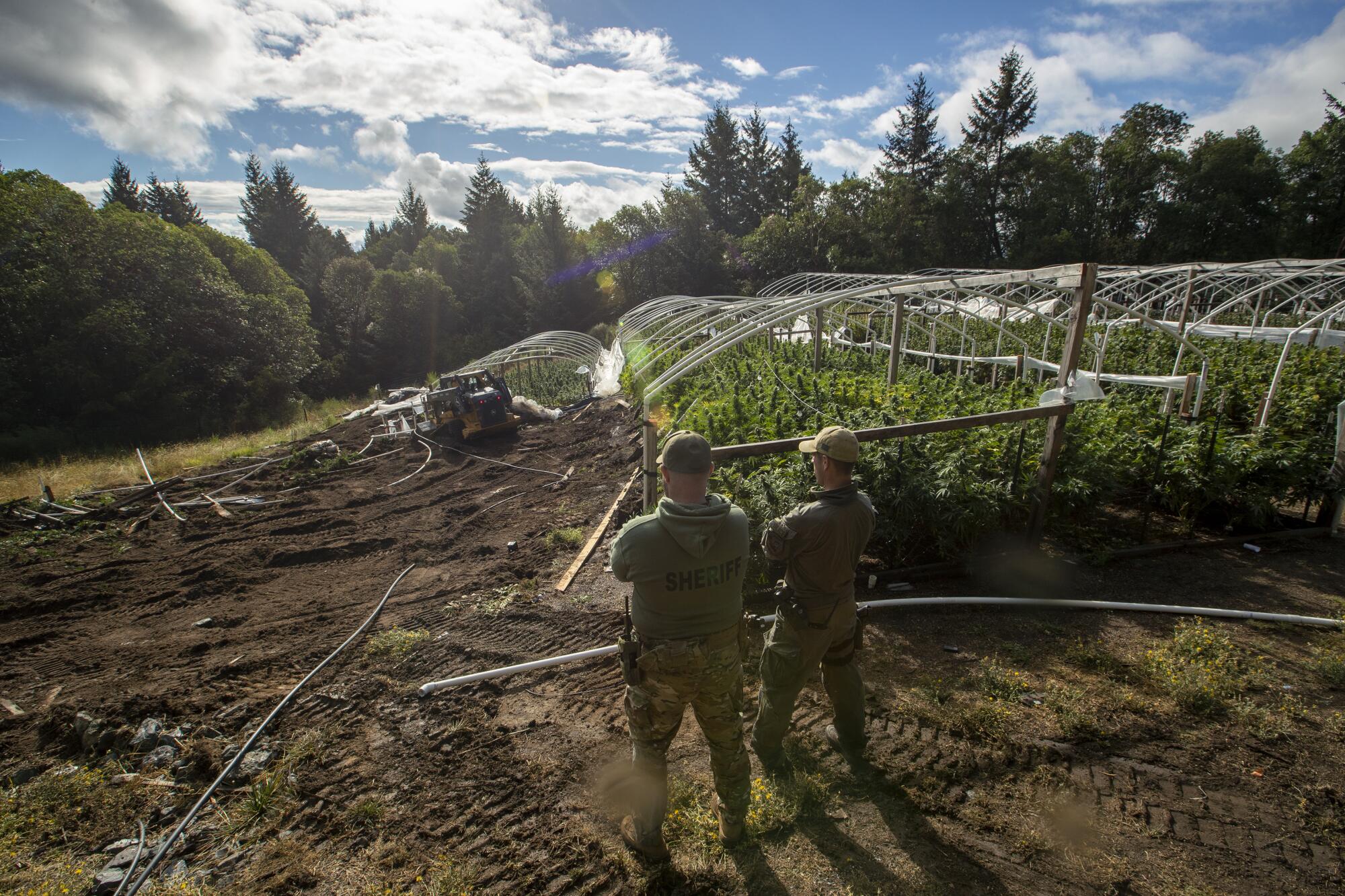
Four California Department of Cannabis Control employees said they are often disturbed by the labor conditions they see and feel frustrated that there is nothing in cannabis regulations that deals with those situations. They spoke on condition of anonymity out of fear of losing their jobs.
Five years after legalization, the agency had yet to establish a protocol for suspected human trafficking, itself a criminal offense that doesn’t cover the vast majority of exploitative work conditions.
In an October email exchange obtained by The Times, a branch manager told division chiefs at the licensing agency that inspectors were finding “circumstantial evidence of human trafficking,” including poor housing, wage complaints and allegations of violent threats. The agency’s enforcement chief replied that his office was setting up criteria for such referrals.
Cannabis workers frequently said they complained to the licensing agency about abusive farms. In a written response to questions from The Times, the agency refused to provide information about the labor complaints, saying any allegation against a licensed farm is confidential unless a finding is made. But, the department said, it has never “issued a final decision against a licensee for wage theft or workplace violations.”
The cannabis licensing agency said that it “takes the treatment of workers seriously” but that aggrieved employees should take their complaints to the Department of Industrial Relations, a sprawling state agency that deals with workplace safety, wages and workers’ compensation.
In the last two years, the labor agency said, its field officers scrutinized four cannabis farms. They included a San Mateo County hemp farm where the owner was prosecuted by the local district attorney for grand theft of labor and sentenced to a year in prison.
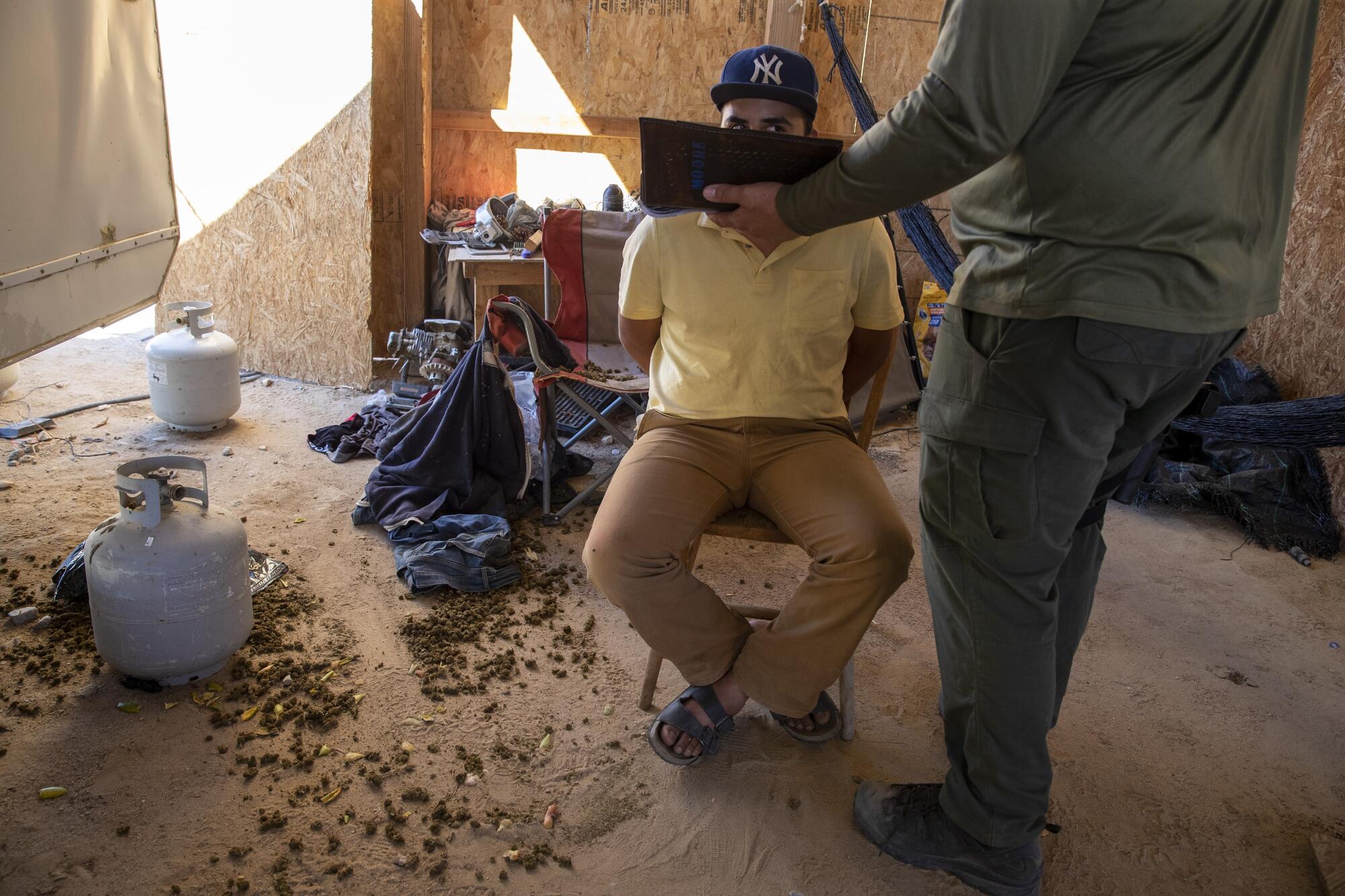
In most cases, workers must trigger action themselves. They can file claims for unpaid wages that by law the Industrial Relations Department must address within 4½ months.
The labor agency said it does “everything possible” to meet the legal time limits, but The Times found workers often waiting a year or more.
The law contains a loophole allowing delays that lead to “an equitable and just resolution.” But nearly half of 67 cannabis-related complaints closed since 2019 were dropped because workers withdrew or “abandoned” their claims, including those who could no longer be located. In six cases, the agency found in favor of workers. The remaining cases were settled privately between the workers and employers.
In one case, an advocate for two brothers who were Yolo County farmworkers told the state someone had threatened to kill the pair if they did not withdraw their claim. “Our clients fear for their lives,” she wrote to the state, asking for an expedited hearing.
The brothers already had waited a year. Seven more months passed before a hearing was held, and it was an additional four months before an administrative law judge told the workers they had won their case.
Workers repeatedly told The Times that they feared filing a wage claim would create a paper trail that could be tracked by immigration authorities, who could then bar them from returning to work the next season. Many also feared connections that they believed licensed farmers had to the criminal world.

Outlaw rules still govern much of the labor relations of cannabis. Workers take jobs on handshake deals struck in grocery store parking lots with owners whose full names they don’t know, following their new bosses into the mountains on nothing more than their word.
A worker could trust Kali Flower Farms, said its owner, Alessandro del Sordo, a loquacious 47-year-old with a tattoo of a grinning pirate skull wrapped around his neck. Del Sordo said he treated his laborers well. He said he held cookouts for the trimmer crews, gave them time to rest before the harvest and doled out bonuses.
The Mendocino County farm had been in operation for five years. During Kali Flower’s early flush years, Del Sordo used the profits to expand, purchase a stake in another farm and buy vehicles, including a $60,000 Mercedes-Benz. But he said the farm couldn’t survive the 2021 collapse in cannabis prices, the damage to crops caused by cold weather and cultivation mistakes. In two seasons, Del Sordo’s lawyer told a judge in his divorce proceedings, the farm racked up $210,000 in wage debt to more than two dozen workers. Workers said they think the amount is higher.
Del Sordo said he walked away from the farm and now lives in a friend’s yurt without indoor plumbing. Any sympathy he could voice for the workers was eclipsed by his claim they could make up their losses by working hard somewhere else.

Subscribers get exclusive access to this story
We’re offering L.A. Times subscribers special access to our best journalism. Thank you for your support.
Explore more Subscriber Exclusive content.
“I would love to say to all of the employees, like, you know, that I’m really sorry that I couldn’t ... pay them,” he said, peppering his words with expletives. “You guys are losing, like $3,000, $5,000, $4,000. I’m losing my whole ... life.”
Del Sordo acknowledged that when a worker told him the laborers were organizing a lawsuit to collect their wages, he threatened to report them to immigration authorities. “I’m like, ‘Don’t open that door, because I love fighting,’” he said. “‘Get your ass out of the ... country.’”
His workers posted warnings to other laborers about the farm in WhatsApp group chats. Four of them also spoke to The Times, describing the lack of housing on the farm, washing in irrigation water and running out of food. They relied on a food bank more than an hour away.
A laborer said he often lay awake in sadness, listening to the sobs of a woman from Mexico, a worker like himself, stuck on the ridge far from home.

It was payday in the tiny Humboldt County community of Honeydew, and Eduardo stepped up to receive his wages for the week.
Instead of the $1,500 he was due, the boss handed him $700.
“You’re short, right?” Eduardo asked.
“No, no, no,” the boss replied, lifting the edge of his shirt to show a pistol, Eduardo said. “That’s all of it.”
Such threats are common, said Eduardo, a 41-year-old from Spain who asked to be identified only by his first name to avoid detection by immigration authorities. He said that in five years he has been repeatedly cheated and threatened.
“Because we are immigrants or because we are working in something illegal,” he said, “they think that truly we are really defenseless.”
Traveling remote areas and further isolated by language barriers, cannabis workers often turn to private groups on Telegram and WhatsApp. These insider channels offer leads on jobs and border-crossing advice and serve as a marketplace for cheap vehicles to live in, and cheap mechanics to fix them. In the face of deteriorating labor conditions, the platforms are also where workers seek a measure of self-protection, by way of “black list” warnings that name farms accused of exploiting workers.
“Farmer VIOLENTO y que no paga,” a worker posted in August, reporting a violent farmer in Mendocino County who ran off two laborers rather than pay them.
In Mad River, workers said they chose to leave a Trinity County farm with half their wages out of fear that if they asked for the rest, their boss would pull a gun on them.

At a state-licensed farm in nearby Hayfork, a worker said that when she threatened to call police and report the operation for missing wages, the owner grabbed her by the neck and choked her. Another worker said five others had reported similar experiences at that farm.
And in Covelo, notorious for its homicides, a man wrestled with the bleakness of working without pay and food while fearing his armed bosses who he said were using hard drugs.
“Leave from there, bro,” a worker advised in Spanish. “Neither money nor weed is more important than one’s life. We all have to run one day.”
“Thanks, bro, I’m already planning my escape,” he replied with a frowning emoji and praying hands. “There will be something good out there.”
In an interview with The Times, a 32-year-old trimmer from Mexico described arriving this summer at an illegal farm a few miles north of the Oregon border. Forty workers shared a single, filthy bathroom, she said.
She said helicopters began to pass overhead, spooking the farm’s armed foremen. The workers were herded at gunpoint into shipping containers to hide, frightening her so much that she and her companions left.
After five months of moving from farm to farm, fed up with sleeping in cold tents, going without showers and not getting paid, she returned to Mexico.
“They threaten you with guns and tell you to leave without getting paid,” she said. “There are many who die and no one knows where they are.”

Death in the cannabis fields is alarmingly common. Using coroner’s reports, The Times identified 35 fatalities in eight California and southern Oregon counties over a five-year span through 2021.
Fourteen died from violence, including seven massacred in a 2020 shooting at a farm in Riverside County. The five women and two men, mostly recent immigrants from Laos, were gunned down at peak harvest season in the Anza Valley, a longtime hub for cannabis cultivation. Sheriff’s deputies recovered more than 1,000 pounds of cannabis ready for sale, valued in the millions.
But most of the cannabis farm deaths were caused by carbon monoxide poisoning. Those workers were victims of both unsafe housing and the widespread, profit-driven shift from cultivating outdoors to using greenhouses that allow owners to extend the growing season.
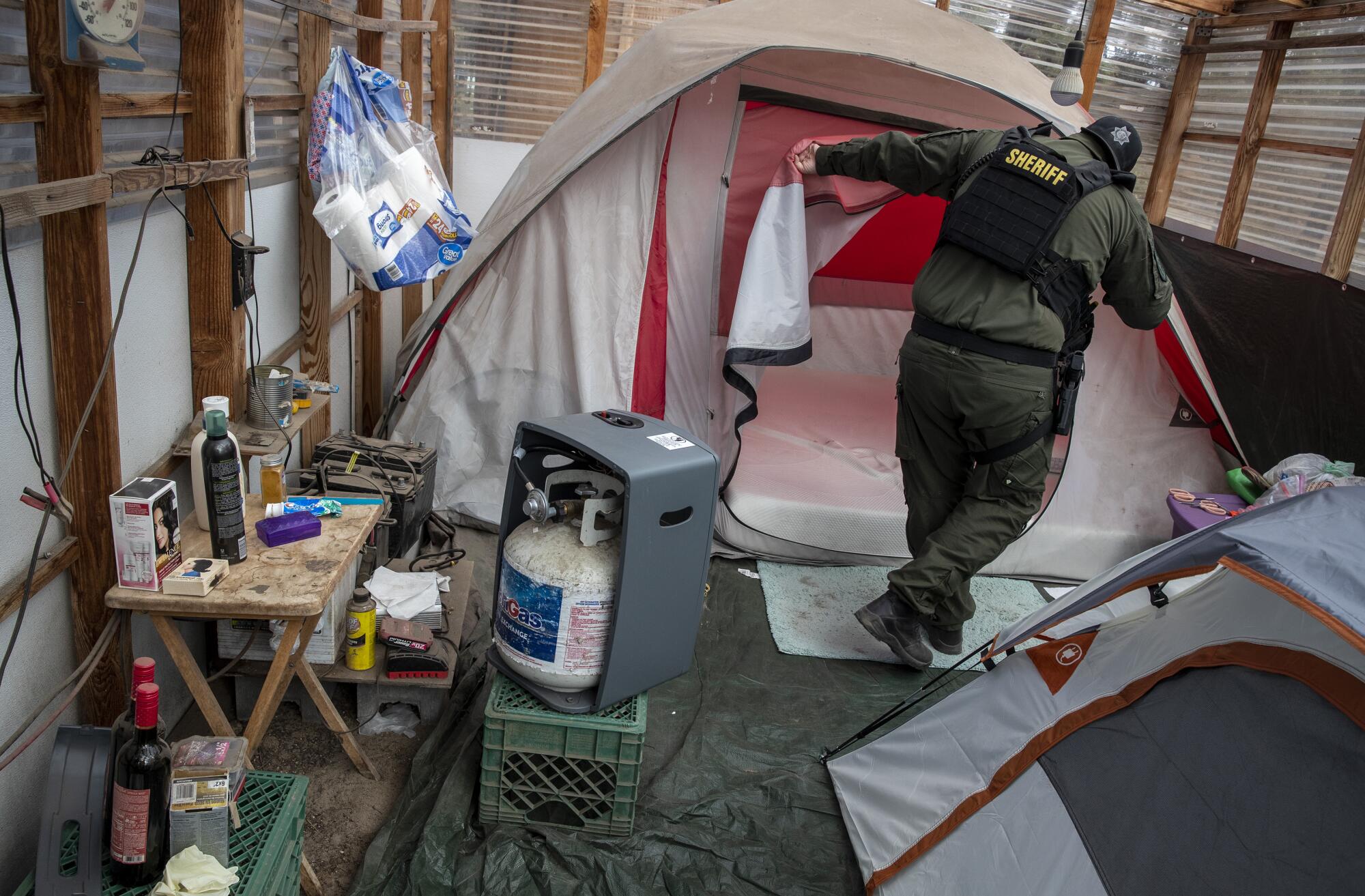
The Times identified eight carbon monoxide deaths in greenhouses and an additional 12 inside trailers or unpermitted shelters on farms. The deaths were compiled primarily from four counties willing to provide coroner reports — Trinity, Siskiyou, Mendocino and Los Angeles. Among them were the deaths of Pa Doua Chang, 44, and Bee Lor, 53, asphyxiated in March 2021 in an outdoor shower rigged with a faulty propane heater, at a licensed cannabis farm atop Post Mountain in Trinity County.
The cause of death for one worker, who collapsed in a greenhouse in Oregon during a heat wave, was never determined.
Of the 35 total deaths, only one was included in a database of worker deaths and serious injuries investigated by the U.S. Occupational Safety and Health Administration. In that instance, the inquiry came five months later when the death of a man who was asphyxiated inside a hemp greenhouse in southern Oregon somehow came to the attention of a workers’ compensation employee.
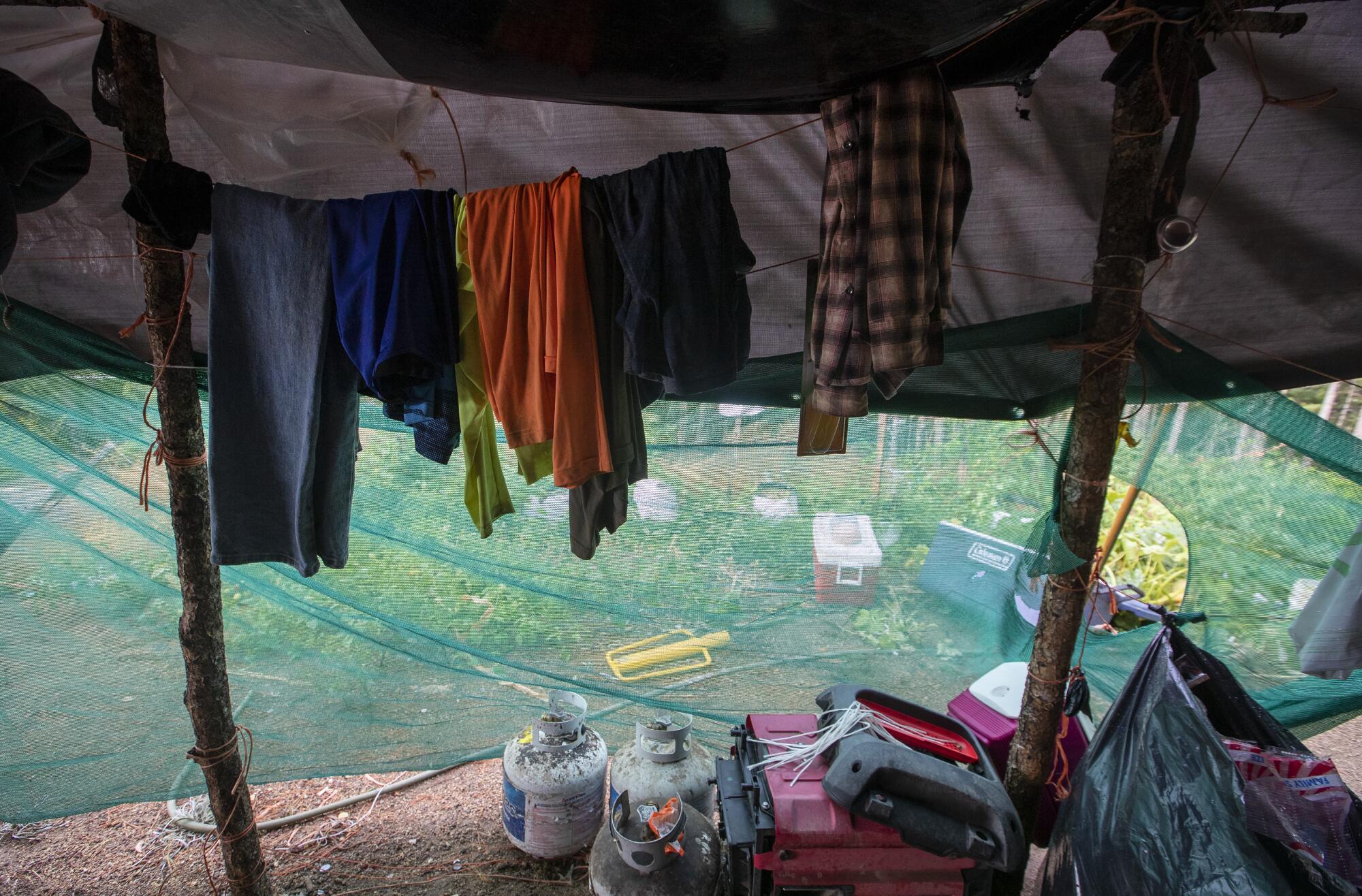
“This is a tragedy,” said Stephen Knight, executive director of Worksafe, a national labor safety organization in Oakland. The cannabis deaths identified by The Times, he said, demonstrate “a pretty dramatic hole in the system for protecting workers.”
California’s legalization of recreational cannabis in 2016 ushered in a multibillion-dollar industry estimated to be the largest legal weed market in the world. But many of the promises of legalization have proved elusive. In a series of occasional stories, we’ll explore the fallout of legal weed in California.
Employers are required to report worker fatalities to OSHA within eight hours, regardless of the legality of the workplace. Most of the deaths identified by The Times took place on unlicensed farms where employers were unknown or unlikely to step forward.
Responding police and fire departments are also required to report workplace deaths. Sheriff’s coroners almost always noted the link to cannabis farms on reports provided to The Times, but those fatalities did not make it into the OSHA database. Sheriff Matt Kendall in Mendocino County — where five workers died — did not think his office had forwarded the fatalities. “Pretty sure that was a missed step on our part,” he said.
But Kendall said he did call California’s local OSHA office in August 2021 to report the living conditions of 27 workers housed in tents and trailers outside an illegal cannabis warehouse. “The OSHA guy didn’t know how to handle the conditions in an illegal grow,” Kendall said. “We were both scratching our heads, wondering how to get that properly reported.”
Nor is it always easy to discern between employer and employee. It also is common practice for large cannabis farms to lease plots to subtenants, making it harder for police to determine who is in charge.
It was early 2020 and Victor Medina, 29, was among a large group of men from San Jose recruited to cultivate plants on a sprawling cannabis operation in Covelo.
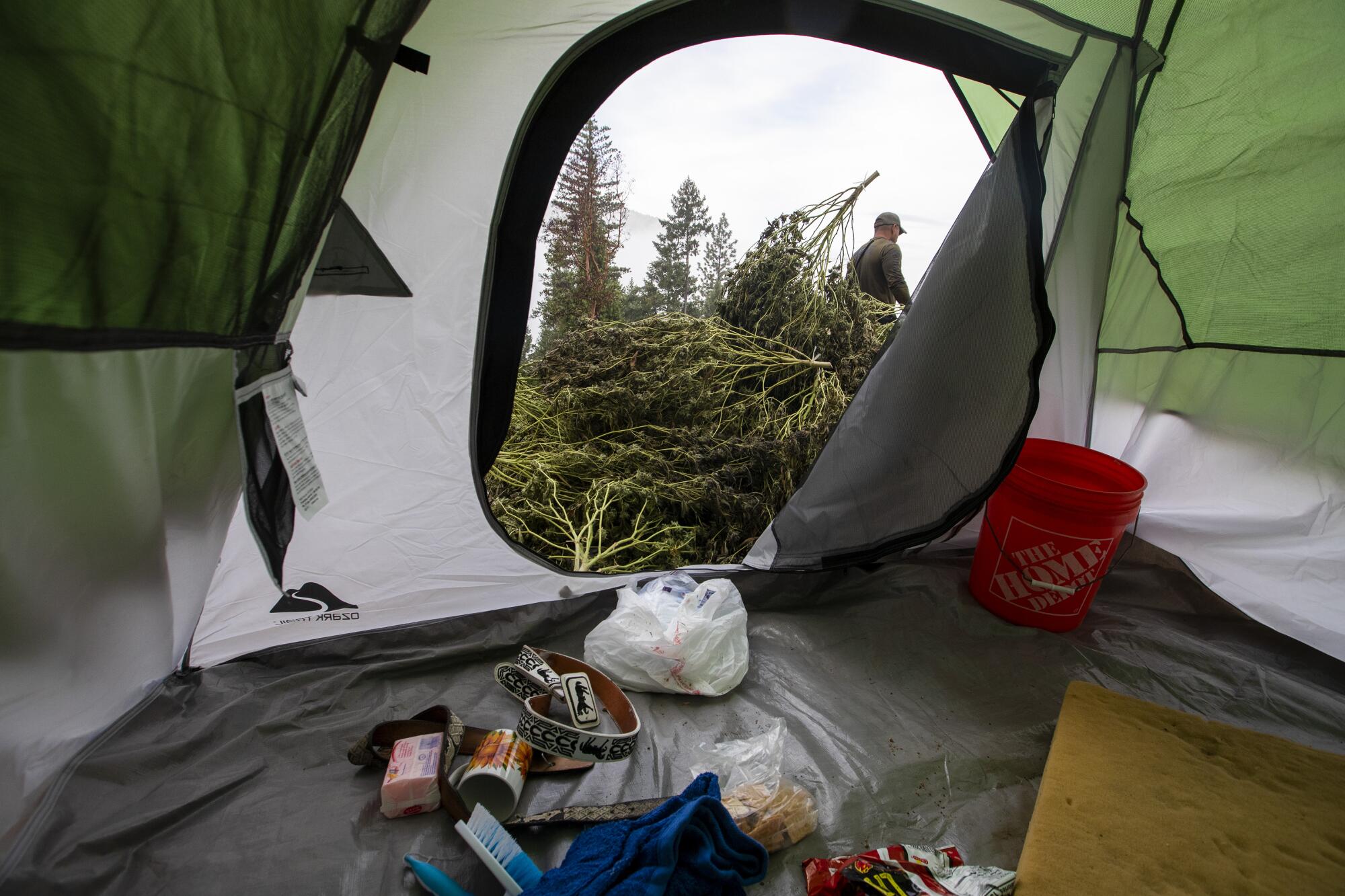
He joined four partners and leased a plot on tribal land across the road from the town landfill. They slept outside in tents, lived off instant noodles and dug holes in the ground for toilets.
Medina’s relatives said he was uneasy and had grown suspicious of others on the compound, including his partners.
Police had their own concerns about safety at such grow sites. Within a five-week span early that season, two workers — one from Honduras and the other from Colombia — died of carbon monoxide poisoning in nearby greenhouses, one of them in the same compound as Medina’s plot. Deputies retrieved the bodies, but the cannabis was on federal trust lands, out of their jurisdiction.
On a Monday in April, Medina disappeared.
Mendocino County sheriff’s deputies searched the cannabis compound, using dogs to scour the scene. They never found his remains, and Medina’s family believes he was murdered.
His relatives made the four-hour drive to Covelo to look for answers. They tacked up missing-person signs on telephone poles and asked around for information, but learned little. A woman warned that Covelo was hostile to outsiders.
Medina’s stepfather, Jesus Alvarado, spent two weeks walking the roads in and around town. Near where Medina’s plot had been, the stepfather said, a truck pulled over and the driver flashed a gun, shouting:
“Go back to where you came from!”

In the Oregon woods, Dagoberto Morales surveyed the rain-soaked debris of an abandoned cannabis labor camp.
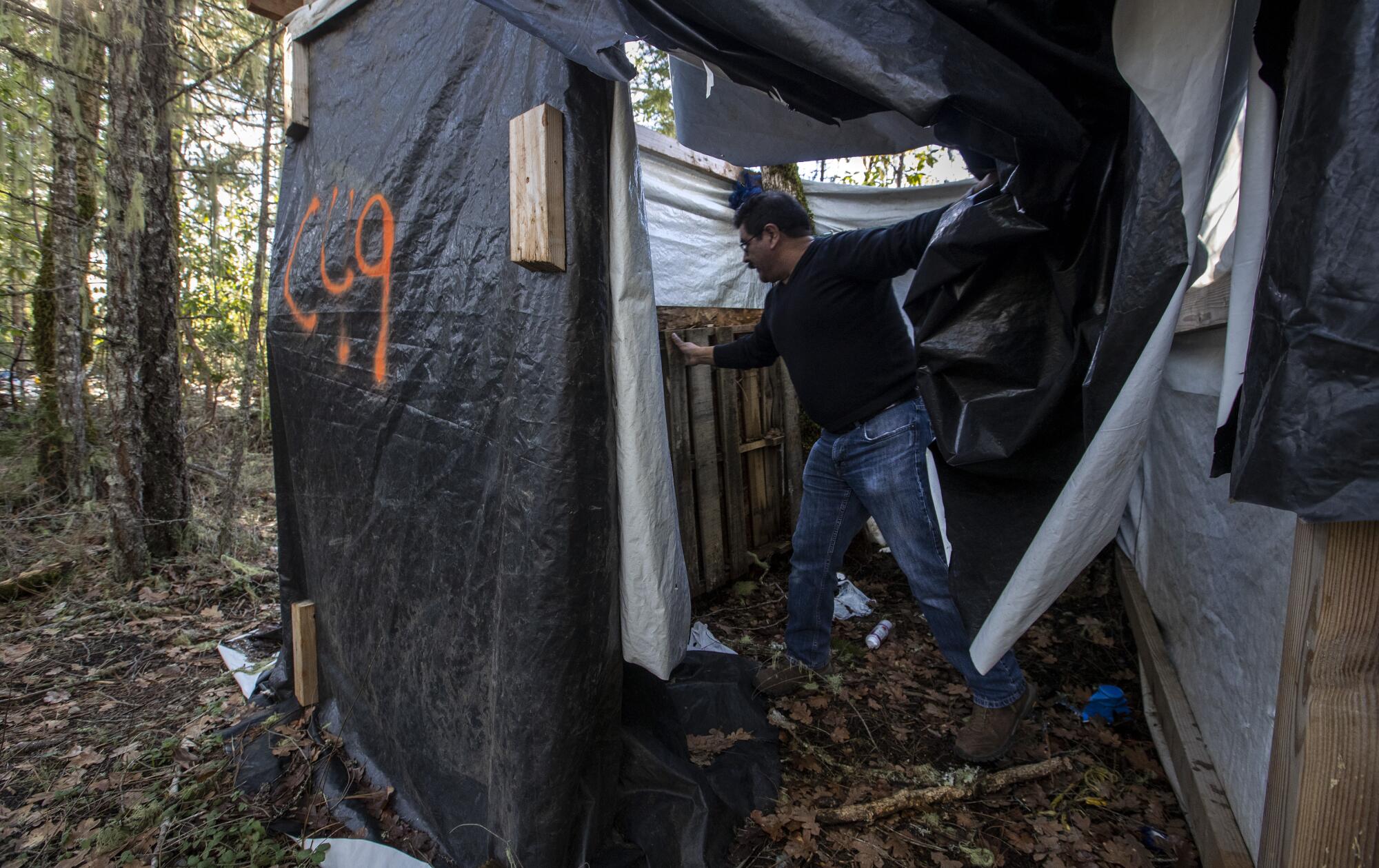
He picked his way past makeshift tables constructed from saplings and dozens of cold shower stalls made from sheets of plastic stapled to trees, each with its own collection of toothbrushes and razors. In places, the ground was littered with wads of toilet paper. A votive of the Virgen de Guadalupe lay on its side.
Morales recognized the lives spelled out by such artifacts. They were like his own, 35 years earlier working in the California strawberry fields, sleeping among the cliffs near Oceanside.
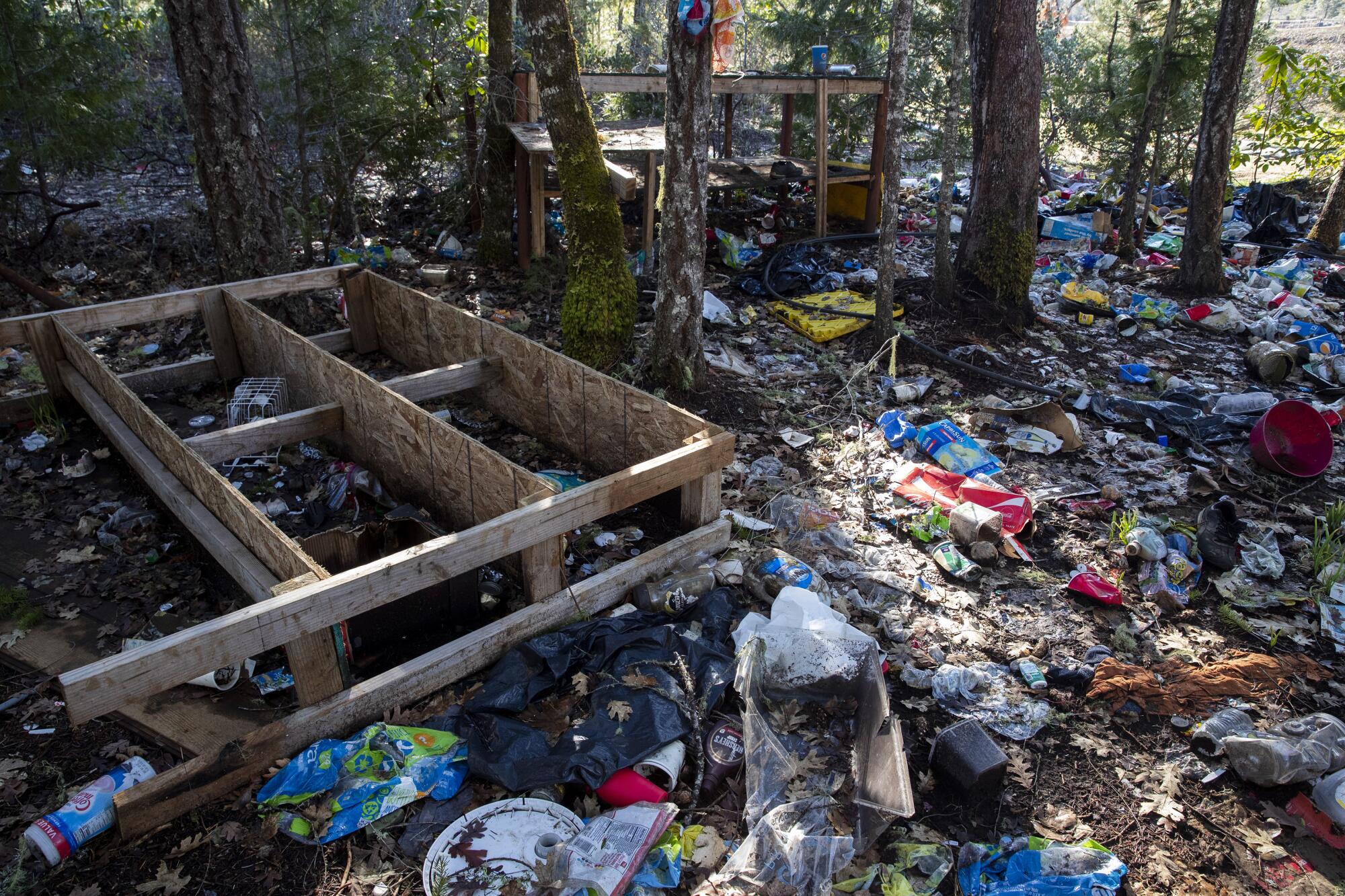
That such a labor camp could exist today told Morales how fast the gains of three decades can be undone.
Morales is the director of Unete, a Medford organization he formed to advocate for pickers in the pear tree orchards of southern Oregon. Increasingly the people contacting Unete for help are workers from cannabis farms in Oregon and California.
Even amid everything Morales has seen, what happened at the camp he explored in January stood out.
One of the hundreds of workers at the camp told The Times they were prohibited from leaving and relied on their employers for food and water. Morales pointed out the absence of fire rings or other features that might have suggested time for leisure or drawn attention from the outside world. The workers were trapped, he said.
“And that’s why they brought these people here,” he said, “because they know they can’t go anywhere.”

Unete counseled more than 200 cannabis wage theft victims in 2021. It has lobbied Oregon to conduct field inspections and hire more wage claim investigators. And the organization goes to the site of police raids to offer displaced workers hotel rooms or plane tickets home. It has also sought to enlist the aid of the Mexican Consulate.
But Morales doubts progress can be made until regulators look beyond borders and acknowledge the immense profits and global exploitation wrapped into cannabis.
“We see people from Mexico, from Chile, from Argentina, from Colombia, from Spain,” he said. “It’s time for all governments to start working together. We have no choice.”
The camp where Morales spoke stretched half a mile along the Illinois River, by the old Q Bar X cattle ranch. It was the largest of the giant, illegal farms occupying southern Oregon in addition to hundreds of small ones.
“The amount of greenhouses is crazy,” said a pilot who flew a Times reporter and photographer over the rural landscape. Nearly every grass valley and timbered ridge was studded with canopied greenhouses — most invisible from the ground but so extensive that, from the sky, it looked as if the land had been infested by giant white caterpillars.
The labor force required to tend those farms is immense and hard to hide.
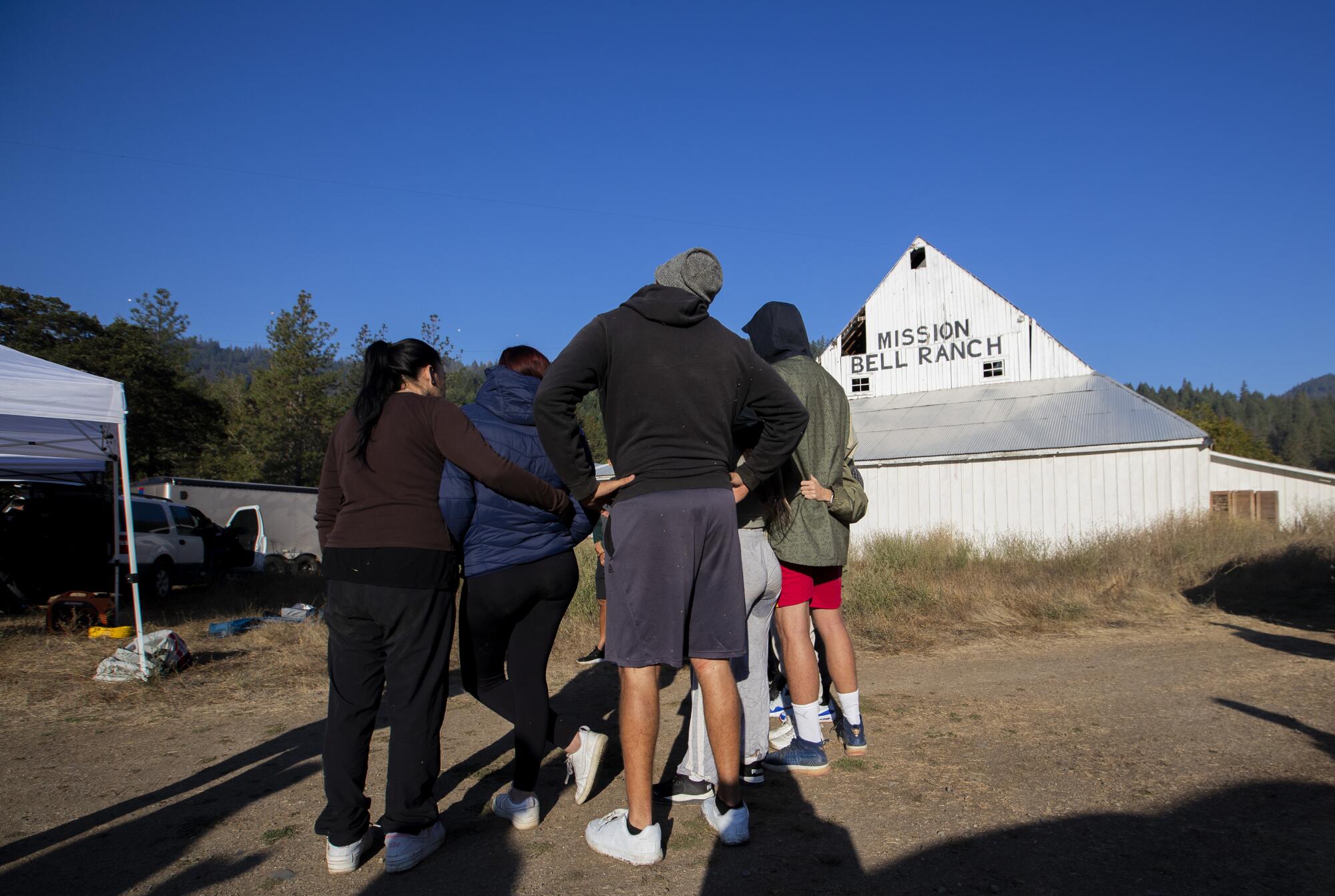
In August 2021, a small army of federal Department of Homeland Security agents, state police and county deputies raided Q Bar X, following the trail of trucks from another large cannabis operation where a worker from Mexico named Crescencio Mejia had collapsed and died. Callers told the Josephine County Sheriff’s Office that hundreds of workers were locked inside Mejia’s farm, forced to sleep on greenhouse floors, without sufficient food and water.
In the two weeks it took for police to assemble a large enough raid party, Mejia’s farm was vacated. But at Q Bar X, police said they found more than 370 greenhouses and detained and questioned more than 200 workers, including some who believed they were still in California. Local residents described watching other workers jump into the river to escape.

Among those who fled across the river was a middle-aged woman from Medford, who told The Times that her job at Q Bar X promised good money — $180 a day, far more than other field jobs. But unlike at her previous jobs at cannabis farms where middlemen sometimes arranged group housing and ferried workers between farms, the bosses at Q Bar X didn’t let them leave.
It was her job, and that of her sister, to cook for the hundreds of workers at the camp. They used an outdoor kitchen stocked with sacks of rice, dried lentils and crates of eggs. They slept in a small tent within a hoop house. It was uncomfortable, she said, but they needed the work.
“If that’s the only place where I can get a job,” she said, “that’s where I will go.”
L.A. Reads
L.A. Guides
Times staff writers Cindy Chang and Anh Do contributed to this report.
- Share via
Watch L.A. Times Today at 7 p.m. on Spectrum News 1 on Channel 1 or live stream on the Spectrum News App. Palos Verdes Peninsula and Orange County viewers can watch on Cox Systems on channel 99.
More to Read
Sign up for Essential California
The most important California stories and recommendations in your inbox every morning.
You may occasionally receive promotional content from the Los Angeles Times.









